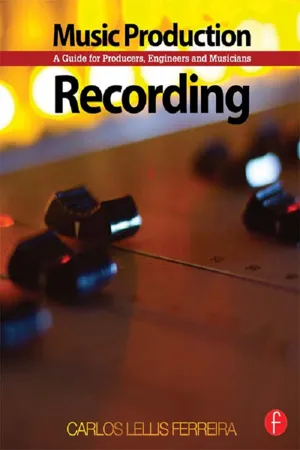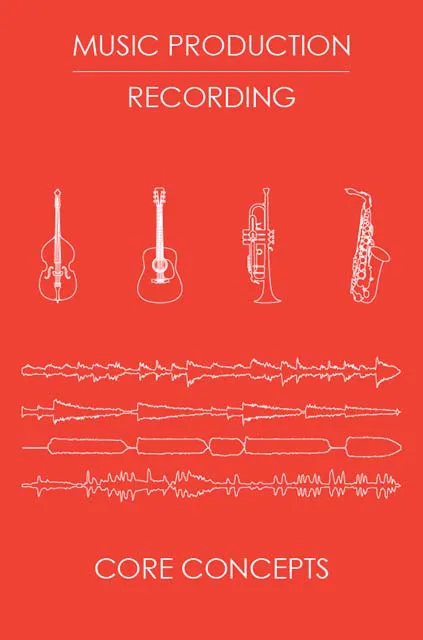![]()
![]()
RECORDING ENVIRONMENTS
Music is created in a multitude of environments, ranging from sophisticated and commonly expensive high-end recording studios to small bedrooms. With this in mind, serious recordists must be prepared to capture performances in any space considered suitable by music makers, including venues selected for reasons other than their sonic attributes (which may seem frustrating to those expecting to always operate under ideal circumstances).
The evaluation of a potential recording space is not simple, as a number of indirectly related and at times unpredictable factors may affect the result of sessions. In fact, in some circumstances the selection of recording settings based on emotional criteria may yield results that justify a sacrifice in sound quality, e.g. when comfort outweighs unfavourable acoustics.
Regardless of what supports the choice of location, recordists must be able to appraise and optimise their working conditions, ensuring that projects can be completed successfully within their given circumstances.
TRADITIONAL RECORDING STUDIOS
What is considered here as a traditional recording studio is any complex consisting of ‘live’ and control rooms, based around medium or large-format mixing consoles and offering all the other common elements of audio signal chains, e.g. cabling, microphones, signal processing devices, recorders, etc. The number of such studios has declined significantly since the introduction of affordable digital audio workstations and the proliferation of home studios, although many producers and artists still feel that they are the ideal place for music recording.
The following are a few advantages of working in well-established recording studios:
1. History / Tradition
Musicians commonly gain confidence when working in environments where other successful albums were made, e.g. a band recording at Abbey Road Studios for the first time will most likely confirm the power of tradition.
2. Equipment
The equipment found in established studios is commonly of high quality and it undergoes maintenance checks and repairs at regular intervals.
3. Acoustics / Environment
There is something to be said for working in an environment entirely dedicated to the making of music. The acoustics of high-end studios are the result of careful planning and significant investment.
4. Personnel
Studio personnel are required to know their premises in great detail in order to work efficiently and support visiting producers, engineers, musicians, etc.
5. Focus
High-end recording studio time is commonly expensive, which may lead producers, engineers and artists to focus and work with greater intensity. It is important to note that this may easily have the opposite effect on some individuals.
TEMPORARY / ‘RESIDENTIAL’ RECORDING SPACES
Residential recording spaces come in different shapes and sizes. Some share the characteristics of large commercial studios, while others may be substantially less sophisticated. The main advantages of recording in live-in settings arise from the possible isolation from the ‘outside world’.
It is not uncommon for a collaborative bond to be created between production teams working in residential settings that would be difficult, if not impossible, to recreate in traditional studio environments.
PROJECT / HOME STUDIOS
‘Project’ and home studios have grown significantly in number since the introduction of affordable DAWs and today a great number of musicians own and are able to operate simple, computer-based, recording set-ups.
The following are some of the advantages of recording in a domestic environment:
• Artists are able to work whenever they feel inspired.
• Artists may feel less pressured to produce results.
• Introverted artists may feel more confident working in the comfort of their own home.
• Artists are able to save money that would otherwise be used for studio rental.
It is nevertheless important for home recordists to be aware of their set-up’s limitations, where the quality and condition of equipment and the overall acoustic characteristics of the recording and monitoring environments may not allow for professional-sounding results to be achieved.
LOCATION / LIVE PERFORMANCE VENUES
What is considered here as work on location is any production carried out in environments that are not fully dedicated to the recording of music and that may only be accessed for a restricted length of time, i.e. settings that require the recording team to set up and break down immediately prior to, and after work respectively. The recording of live performances is a variant of such work, with the added element of ‘pressure’ originating from:
• The presence of a paying audience
• The possibility of ‘live’ broadcasting
• The likelihood of two independent teams working in tandem.
Although the recording of concerts is not the primary focus of this book, all the information included here may be applied to ‘live’ work.
![]()
THE RECORDING TEAM
A recording team may have some or all of the following elements:
• Musicians
• Programrs
• Runners
• Tape operator
• DAW operator / Editor
• Assistant engineer
• Main engineer
• Producer
• Others.
It is not always easy to delineate the roles and responsibilities of those involved in music production. This is particularly true in the case of modest budget projects, where individuals are commonly required to operate in multiple capacities and the labelling of roles and responsibilities may seem pointless. Still, in traditional recording environments a clear outline of functions often leads to a better distribution of labour and the more efficient use of time.
The following is a brief description of the members of conventional recording teams and their roles:
MUSICIANS
Musicians are defined here as the individuals that generate sound during the recording stage of a production. This applies to those that utilise both traditional and non-traditional instruments, e.g. turntables, etc.
PROGRAMMERS
Programrs may contribute to music production by selecting or creating electronic instrument ‘patches’, programming drumbeats, generating sequences, etc., which may occur during the pre-production, recording or the mixing stages.
RUNNERS
Runners (or ‘tea boys’) are commonly the youngest members of the recording team. Their tasks can be varied and commonly include peripheral or indirectly related activities that help sessions flow smoothly, e.g. purchasing of media, catering, etc.
THE TAPE OPERATOR
The ‘tape op’ is responsible for the basic maintenance and the operation of tape recorders. This position is no longer common in music production.
THE DAW OPERATOR / EDITOR
A DAW operator should know audio software programs and their corresponding hardware in great detail, being able to work with them during the recording, editing and mixing stages of production.
THE ASSISTANT ENGINEER
This role requires the most flexibility, as the duties of the assistant engineer may span from those of a ‘runner’ to those of a main recording engineer. It is presently not uncommon for assistant engineers to also be responsible for ...

